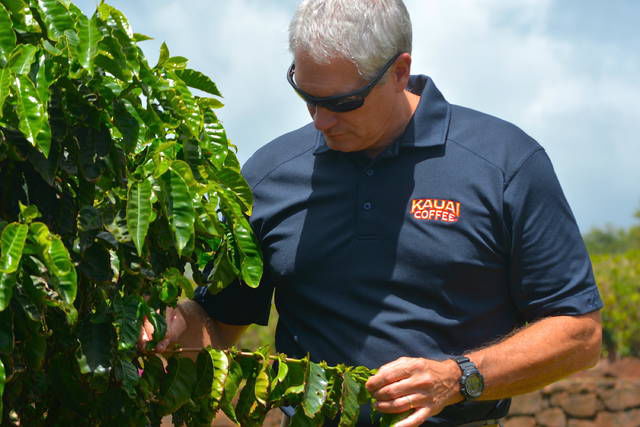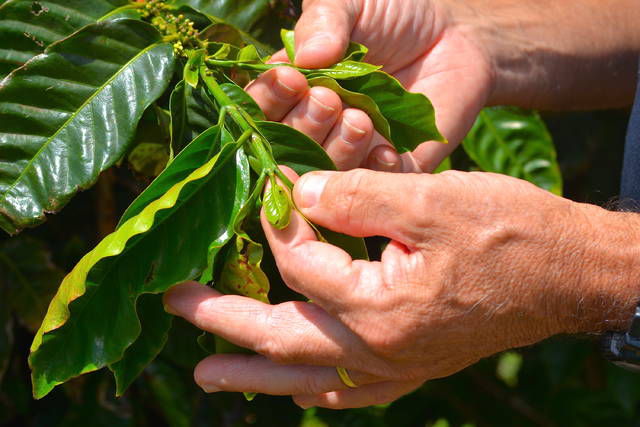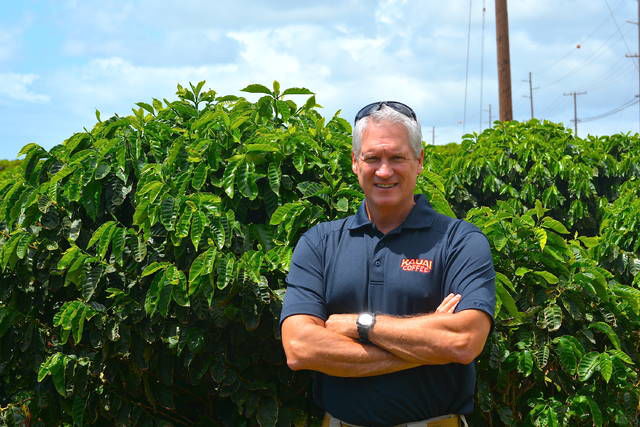KALAHEO — Kauai Coffee Company had such an improved harvest in 2016 that it eliminated the deficit in 2015, said general manager Fred Cowell. “We were up from the previous year and it was a result of the drought that
KALAHEO — Kauai Coffee Company had such an improved harvest in 2016 that it eliminated the deficit in 2015, said general manager Fred Cowell.
“We were up from the previous year and it was a result of the drought that we had in 2015. In the spring of 2016, we had near perfect flowering conditions which helped,” Cowell said. “Basically, we made up for the loss we had for the previous year. The increase this past season almost equaled the deficit we had in 2015-2016.”
Federal statistics show Hawaii’s coffee season for the 2016-17 year looks promising statewide with an increase in production, yield and value.
The U.S. Department of Agriculture’s preliminary season estimates released in February show Hawaii is expected to have produced more than 36 million pounds of coffee cherry this past season. That is up nearly 2 million pounds from the previous 2015-16 season, West Hawaii Today reported.
Coffee cherry is the entire fruit when it is picked.
The USDA’s National Agricultural Statistics Service valued Hawaii’s crop during the most recent season at more than $62 million, with each pound of the cherry selling at $1.71. During the 2015-16 season, Hawaii’s crop was valued at only about $54 million.
Despite the predicted statewide growth, coffee farmers in Kona on the Big Island said they experienced a rough growing season due to dry weather.
“In Kona, we actually had a pretty terrible year,” said Kona Coffee Farmers Association President Suzanne Shriner. “A lot of people had to file for crop insurance because of the extended dry period from October to March.”
Shriner said the Kona coffee region did not see an overall production increase as reported in the estimates for the state’s 6,900 acres of coffee-producing land.
“When they (NASS) report the crop is up that includes the big farms on Kauai and Maui, and they may have had some better yield,” Shriner said. “It’s hard. We’d love to see it broken down by county; a few years ago they used to do that and then they lumped it together statewide.”
Walter Kunitake, owner of Country Samurai Coffee Co. in Holualoa, said he also did not receive enough rain for his Big Island crop during the 2016-17 season.
Cowell said that Kauai’s harvest accounts for roughly a third of the state’s total harvest. He also said that companies can’t always rely on perfect weather, and sometimes a bit of innovation must occur in order to keep the harvest alive.
“It really has a lot to do with the weather,” Cowell said. “We’re making up for climatic conditions with technology and ingenuity — irrigation and farms practices, those type of things.”
Cowell told The Garden Island that it’s been “near impossible” to predict how each year’s crop will do ahead of time, citing forces that are outside of human control.
“We’re thankful when we get great conditions and bite our lip when we get less than perfect conditions,” he said. “It’s a very difficult business.”
But both Kunitake and Shriner said things are looking up for the 2017-18 coffee season.
“We’re looking much better than last year as once again we are in the swing of things and we should have an up year,” Shriner said. “We just had a big flowering a week ago — the flowers were all the way to the end of the branches, which usually indicates a healthy crop year for us.”
Kunitake’s crop has also flowered substantially with blossoms growing on branches from trunk to tip in recent weeks.
“It’s going to be a good crop; I’m trying my best,” he said. “It will depend on how much precipitation we get from here on to sustain them. Water is life — if you get no water all those guys (trees) will abort.”
•••
West Hawaii Today contributed to this story.




